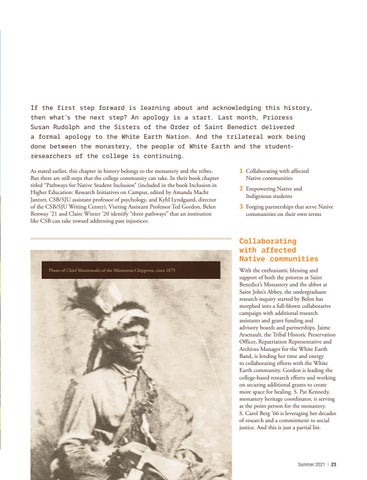If the first step forward is learning about and acknowledging this history, then what’s the next step? An apology is a start. Last month, Prioress Susan Rudolph and the Sisters of the Order of Saint Benedict delivered a formal apology to the White Earth Nation. And the trilateral work being done between the monastery, the people of White Earth and the studentresearchers of the college is continuing. As stated earlier, this chapter in history belongs to the monastery and the tribes. But there are still steps that the college community can take. In their book chapter titled “Pathways for Native Student Inclusion” (included in the book Inclusion in Higher Education: Research Initiatives on Campus, edited by Amanda Macht Jantzer, CSB/SJU assistant professor of psychology, and Kyhl Lyndgaard, director of the CSB/SJU Writing Center), Visiting Assistant Professor Ted Gordon, Belen Benway ’21 and Claire Winter ’20 identify “three pathways” that an institution like CSB can take toward addressing past injustices:
1 C ollaborating with affected Native communities 2 E mpowering Native and Indigenous students 3 F orging partnerships that serve Native communities on their own terms
Collaborating with affected Native communities Photo of Chief Manitowabi of the Minnesota Chippewa, circa 1875
With the enthusiastic blessing and support of both the prioress at Saint Benedict’s Monastery and the abbot at Saint John’s Abbey, the undergraduate research inquiry started by Belen has morphed into a full-blown collaborative campaign with additional research assistants and grant funding and advisory boards and partnerships. Jaime Arsenault, the Tribal Historic Preservation Officer, Repatriation Representative and Archives Manager for the White Earth Band, is lending her time and energy to collaborating efforts with the White Earth community. Gordon is leading the college-based research efforts and working on securing additional grants to create more space for healing. S. Pat Kennedy, monastery heritage coordinator, is serving as the point person for the monastery. S. Carol Berg ’66 is leveraging her decades of research and a commitment to social justice. And this is just a partial list.
Summer 2021 | 23
